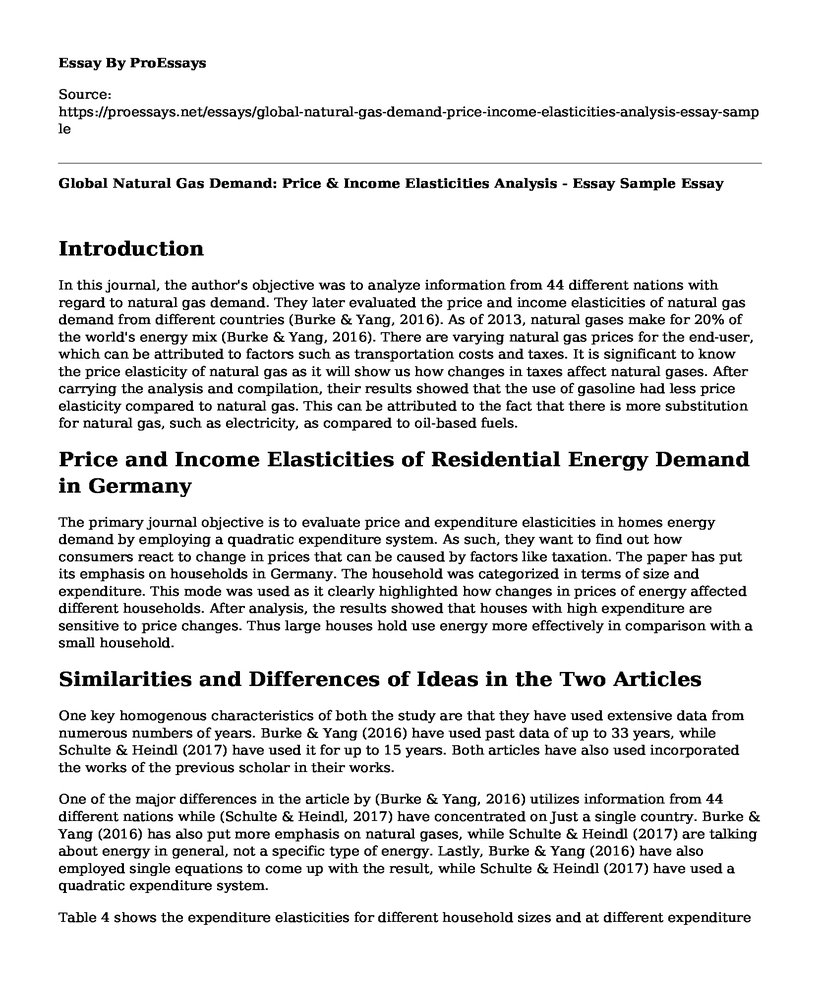Introduction
In this journal, the author's objective was to analyze information from 44 different nations with regard to natural gas demand. They later evaluated the price and income elasticities of natural gas demand from different countries (Burke & Yang, 2016). As of 2013, natural gases make for 20% of the world's energy mix (Burke & Yang, 2016). There are varying natural gas prices for the end-user, which can be attributed to factors such as transportation costs and taxes. It is significant to know the price elasticity of natural gas as it will show us how changes in taxes affect natural gases. After carrying the analysis and compilation, their results showed that the use of gasoline had less price elasticity compared to natural gas. This can be attributed to the fact that there is more substitution for natural gas, such as electricity, as compared to oil-based fuels.
Price and Income Elasticities of Residential Energy Demand in Germany
The primary journal objective is to evaluate price and expenditure elasticities in homes energy demand by employing a quadratic expenditure system. As such, they want to find out how consumers react to change in prices that can be caused by factors like taxation. The paper has put its emphasis on households in Germany. The household was categorized in terms of size and expenditure. This mode was used as it clearly highlighted how changes in prices of energy affected different households. After analysis, the results showed that houses with high expenditure are sensitive to price changes. Thus large houses hold use energy more effectively in comparison with a small household.
Similarities and Differences of Ideas in the Two Articles
One key homogenous characteristics of both the study are that they have used extensive data from numerous numbers of years. Burke & Yang (2016) have used past data of up to 33 years, while Schulte & Heindl (2017) have used it for up to 15 years. Both articles have also used incorporated the works of the previous scholar in their works.
One of the major differences in the article by (Burke & Yang, 2016) utilizes information from 44 different nations while (Schulte & Heindl, 2017) have concentrated on Just a single country. Burke & Yang (2016) has also put more emphasis on natural gases, while Schulte & Heindl (2017) are talking about energy in general, not a specific type of energy. Lastly, Burke & Yang (2016) have also employed single equations to come up with the result, while Schulte & Heindl (2017) have used a quadratic expenditure system.
Table 4 shows the expenditure elasticities for different household sizes and at different expenditure phases. The demographics used are transport, heating, food, and electricity, which are commonly used by each household. The results show that the elasticity of energy goods is on an upward trajectory when the total expenditure increases. Table 5, on the other hand, looks at price elasticity for various household sizes with varying expenditure levels. The demographic used her are transport, food, electricity, and heating. The price elasticity of energy goods is seen to increase with the increment of the total expenditure.
The demand for natural gas, as stated by (Burke & Yang, 2016), is small as compared to gasoline. Natural gases can easily be substituted by electricity, but it is quite hard to substitute gasoline (Benassi & Chirco, 2003). Consequently, price elasticity is more on natural gas compared to gasoline. Price elasticity, on the other hand, according to (Schulte & Heindl, 2017), is high as it rises with expenditure.
Existing literature had reported a lower price elasticity but the results by (Burke & Yang, 2016) that the; aggregate demand for natural gas price elasticity over a long period is more compared to other those research. The authors have also shown us that with the improvement in the economy, so does the demand for natural gas improve. Schulte & Heindl (2017) extensive research has shown how policies can be instituted to save individuals with low income and less expenditure (Thompson, 2004).
References
Benassi, C., & Chirco, A. (2003). Income Distribution, Price Elasticity, and the 'Robinson Effect.' SSRN Electronic Journal. https://doi.org/10.2139/ssrn.448340
Burke, P., & Yang, H. (2016). The price and income elasticities of natural gas demand: International evidence. Energy Economics, 59, 466-474. https://doi.org/10.1016/j.eneco.2016.08.025
Sabatelli, L. (2016). Correction: Relationship between the Uncompensated Price Elasticity and the Income Elasticity of Demand under Conditions of Additive Preferences. PLOS ONE, 11(4). https://doi.org/10.1371/journal.pone.0154487
Schulte, I., & Heindl, P. (2017). Price and income elasticities of residential energy demand in Germany. Energy Policy, 102, 512-528. https://doi.org/10.1016/j.enpol.2016.12.055
Thompson, W. (2004). Using Elasticities from an Almost Ideal Demand System? Watch Out for Group Expenditure!. American Journal Of Agricultural Economics, 86(4), 1108-1116. https://doi.org/10.1111/j.0002-9092.2004.00656.x
Cite this page
Global Natural Gas Demand: Price & Income Elasticities Analysis - Essay Sample. (2023, Jul 20). Retrieved from https://proessays.net/essays/global-natural-gas-demand-price-income-elasticities-analysis-essay-sample
If you are the original author of this essay and no longer wish to have it published on the ProEssays website, please click below to request its removal:
- Essay on Different Types of Cars
- Essay Example: Factors that Account for Significance and Visibility of Motor Carriers
- Legislation Relating to Age and Life Extension of Installations in the North Sea
- The Effect of World Oil and Gas Crises on the Economic Condition of Oman Paper Example
- Electrical and Electronic Engineering: Personal Statement
- What Should Ray Include in His Job Description for the Director of Engineering Position? - Essay Sample
- Essay Sample on British Petroleum Oil Spill Disaster: 5 Million Barrels of Oil in the Gulf of Mexico







